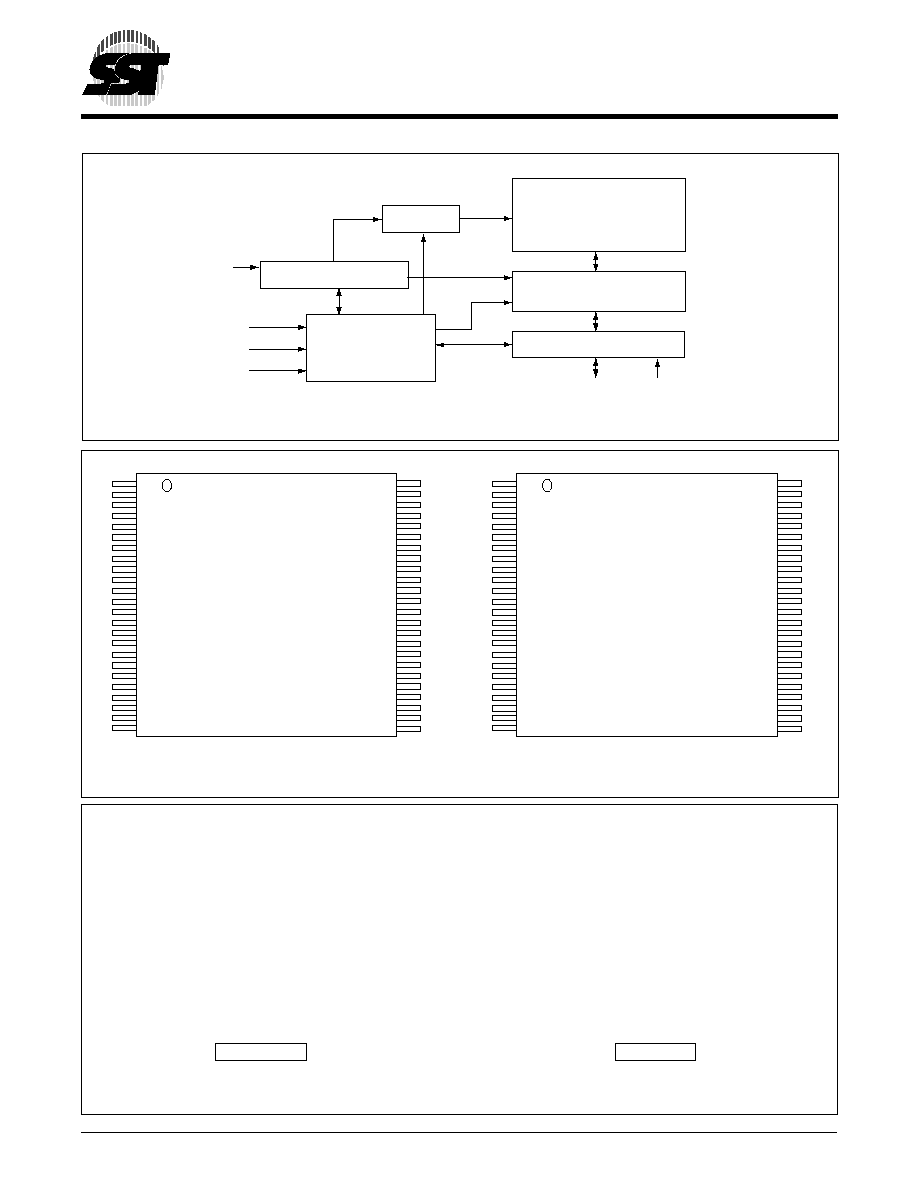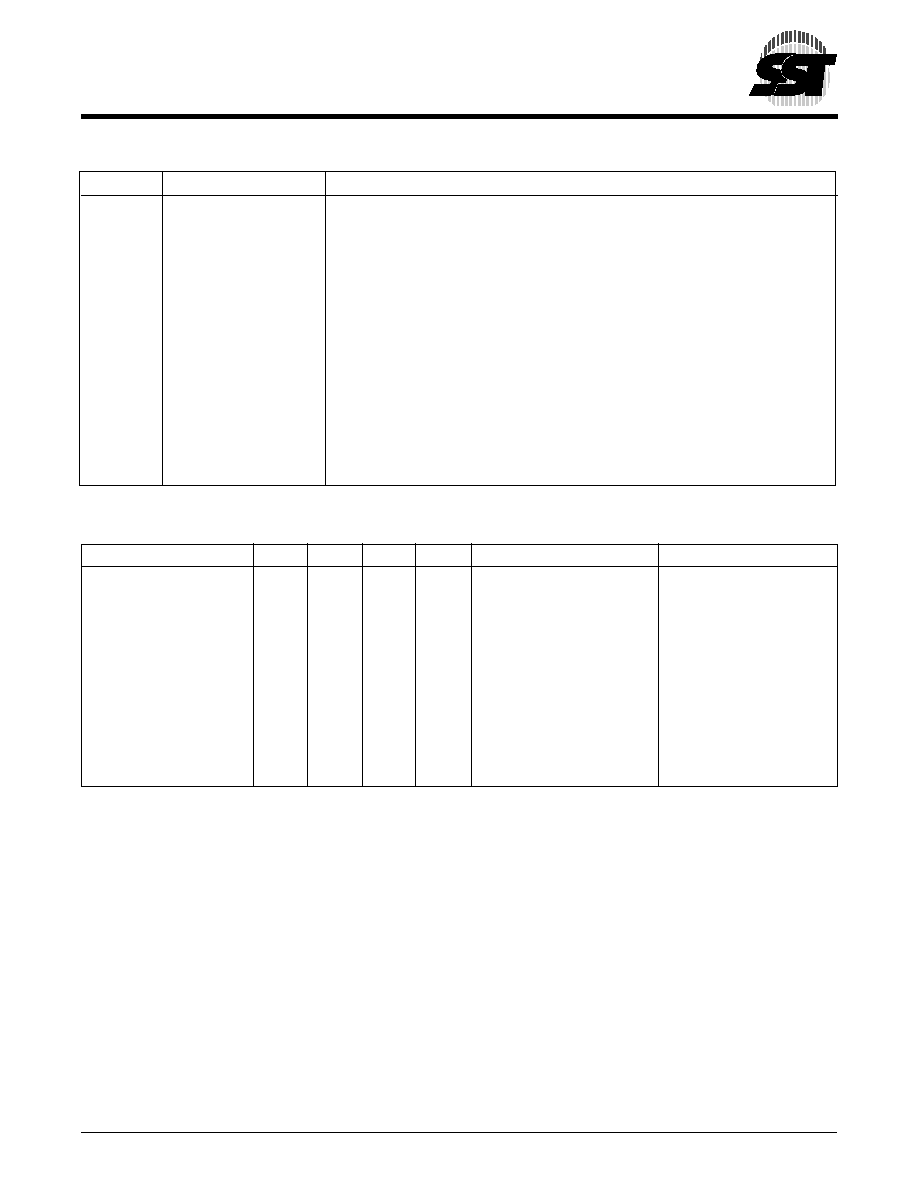
1
16 Megabit (1M x 16-Bit) Multi-Purpose Flash
SST39VF160Q / SST39VF160
Advance Information
1
2
3
4
5
6
7
8
9
10
11
12
13
14
15
16
© 1998 Silicon Storage Technology, Inc. The SST logo and SuperFlash are registered trademarks of Silicon Storage Technology, Inc. MPF is a trademark of Silicon storage Technology, Inc.
329-09 11/98
These specifications are subject to change without notice.
FEATURES:
∑
Organized as 1 M X 16
∑
Single 2.7V-only Read and Write Operations
∑
V
DDQ
Power Supply to Support 5V I/O
for SST39VF160Q
- V
DDQ
not available on SST39VF160
∑
Superior Reliability
-
Endurance: 100,000 Cycles (typical)
-
Greater than 100 years Data Retention
∑
Low Power Consumption:
-
Active Current: 15 mA (typical)
-
Standby Current: 3 µA (typical)
-
Auto Low Power Mode: 3 µA (typical)
∑
Small Sector Erase Capability (512 sectors)
-
Uniform 2 KWord sectors
∑
Block Erase Capability (32 blocks)
-
Uniform 32 KWord blocks
∑
Fast Read Access Time:
-
70 and 90 ns
∑
Latched Address and Data
∑
Fast Sector Erase and Word Program:
-
Sector Erase Time: 3 ms typical
-
Block Erase Time: 7 ms typical
-
Chip Erase Time: 15 ms typical
-
Word Program time: 7 µs typical
-
Chip Rewrite Time: 7 seconds
∑
Automatic Write Timing
- Internal V
pp
Generation
∑
End of Write Detection
-
Toggle Bit
-
Data# Polling
∑
CMOS I/O Compatibility
∑
JEDEC Standard
-
EEPROM Pinouts and command set
∑
Packages Available
-
48-Pin TSOP (12mm x 20mm)
-
6 x 8 Ball TFBGA
PRODUCT DESCRIPTION
The SST39VF160Q/VF160 devices are 1M x 16 CMOS
Multi-Purpose Flash (MPF) manufactured with SST's
proprietary, high performance CMOS SuperFlash tech-
nology. The split-gate cell design and thick oxide tunnel-
ing injector attain better reliability and manufacturability
compared with alternate approaches. The
SST39VF160Q/VF160 write (Program or Erase) with a
2.7V-only power supply. The SST39VF160Q/VF160
conform to JEDEC standard pinouts for x16 memories.
Featuring high performance word program, the
SST39VF160Q/VF160 devices provide a maximum
word-program time of 10 µsec. The entire memory can
typically be erased and programmed word by word in 7
seconds, when using interface features such as Toggle
Bit or Data# Polling to indicate the completion of Program
operation. To protect against inadvertent write, the
SST39VF160Q/VF160 have on-chip hardware and soft-
ware data protection schemes. Designed, manufac-
tured, and tested for a wide spectrum of applications, the
SST39VF160Q/VF160 are offered with a guaranteed
endurance of 10,000 cycles. Data retention is rated at
greater than 100 years.
The SST39VF160Q/VF160 devices are suited for appli-
cations that require convenient and economical updating
of program, configuration, or data memory. For all sys-
tem applications, the SST39VF160Q/VF160 signifi-
cantly improve performance and reliability, while lower-
ing power consumption. The SST39VF160Q/VF160 in-
herently use less energy during Ease and Program than
alternative flash technologies. The total energy con-
sumed is a function of the applied voltage, current, and
time of application. Since for any given voltage range, the
SuperFlash technology uses less current to program and
has a shorter erase time, the total energy consumed
during any Erase or Program operation is less than
alternative flash technologies. The SST39VF160Q/
VF160 also improve flexibility while lowering the cost for
program, data, and configuration storage applications.
The SuperFlash technology provides fixed Erase and
Program times, independent of the number of endurance
cycles that have occurred. Therefore the system
software or hardware does not have to be modified or
de-rated as is necessary with alternative flash technolo-
gies, whose erase and program times increase with
accumulated endurance cycles.
To meet high density, surface mount requirements, the
SST39VF160Q/VF160 are offered in 48-pin TSOP and
48-pin TFBGA packages. See Figures 1 and 2 for
pinouts.
Device Operation
Commands are used to initiate the memory operation
functions of the device. Commands are written to the
device using standard microprocessor write sequences.
A command is written by asserting WE# low while
keeping CE# low. The address bus is latched on the
falling edge of WE# or CE#, whichever occurs last. The
data bus is latched on the rising edge of WE# or CE#,
whichever occurs first.

2
© 1998 Silicon Storage Technology, Inc.
329-09 11/98
16 Megabit Multi-Purpose Flash
SST39VF160Q / SST39VF160
Advance Information
The SST39VF160Q/VF160 also have the Auto Low
Power mode which puts the device in a near standby mode
after data has been accessed with a valid read operation.
This reduces the I
DD
active read current from typically 15
mA to typically 3 µA. The Auto Low Power mode reduces
the typical I
DD
active read current to the range of 1 mA/MHz
of read cycle time. The device exits the Auto Low Power
mode with any address transition or control signal transi-
tion used to initiate another read cycle, with no access time
penalty.
Read
The Read operation of the SST39VF160Q/VF160 is con-
trolled by CE# and OE#, both have to be low for the system
to obtain data from the outputs. CE# is used for device
selection. When CE# is high, the chip is deselected and
only standby power is consumed. OE# is the output control
and is used to gate data from the output pins. The data bus
is in high impedance state when either CE# or OE# is high.
Refer to the Read cycle timing diagram for further details
(Figure 3).
Word Program Operation
The SST39VF160Q/VF160 are programmed on a word-
by-word basis. The Program operation consists of three
steps. The first step is the three-byte-load sequence for
Software Data Protection. The second step is to load word
address and word data. During the word Program opera-
tion, the addresses are latched on the falling edge of either
CE# or WE#, whichever occurs last. The data is latched on
the rising edge of either CE# or WE#, whichever occurs
first. The third step is the internal Program operation which
is initiated after the rising edge of the fourth WE# or CE#,
whichever occurs first. The Program operation, once initi-
ated, will be completed within 10 µs. See Figures 4 and 5
for WE# and CE# controlled Program operation timing
diagrams and Figure 15 for flowcharts. During the Pro-
gram operation, the only valid reads are Data# Polling and
Toggle Bit. During the internal Program operation, the host
is free to perform additional tasks. Any commands issued
during the internal Program operation are ignored.
Sector/Block Erase Operation
The Sector/Block Erase operation allows the system to
erase the device on a sector-by-sector (or block-by-block)
basis. The SST39VF160Q/VF160 offer both small Sector
Erase and Block Erase mode. The sector architecture is
based on uniform sector size of 2 KWord. The Block Erase
mode is based on uniform block size of 32 KWord. The
Sector Erase operation is initiated by executing a six-byte-
command sequence with Sector Erase command (30H)
and sector address (SA) in the last bus cycle. The address
lines A11-A19 are used to determine the sector address.
The Block Erase operation is initiated by executing a six-
byte-command sequence with Block Erase command
(50H) and block address (BA) in the last bus cycle. The
address lines A15-A19 are used to determine the block
address. The sector or block address is latched on the
falling edge of the sixth WE# pulse, while the command
(30H or 50H) is latched on the rising edge of the sixth WE#
pulse. The internal Erase operation begins after the sixth
WE# pulse. The end of Erase operation can be determined
using either Data# Polling or Toggle Bit methods. See
Figures 8 and 9 for timing waveforms. Any commands
issued during the Sector or Block Erase operation are
ignored.
Chip-Erase Operation
The SST39VF160Q/VF160 provide a Chip Erase opera-
tion, which allows the user to erase the entire memory array
to the "1" state. This is useful when the entire device must
be quickly erased.
The Chip Erase operation is initiated by executing a six
byte command sequence with Chip Erase command
(10H) at address 5555H in the last byte sequence. The
Erase operation begins with the rising edge of the sixth
WE# or CE#, whichever occurs first. During the Erase
operation, the only valid read is Toggle Bit or Data# Polling.
See Table 4 for the command sequence, Figure 8 for timing
diagram, and Figure 19 for the flowchart. Any commands
issued during the chip erase operation are ignored.
Write Operation Status Detection
The SST39VF160Q/VF160 provide two software means
to detect the completion of a Write (Program or Erase)
cycle, in order to optimize the system write cycle time. The
software detection includes two status bits: Data# Polling
(DQ
7
) and Toggle Bit (DQ
6
). The end of write detection
mode is enabled after the rising edge of WE#, which
initiates the internal program or erase operation.
The actual completion of the nonvolatile write is asynchro-
nous with the system; therefore, either a Data# Polling or
Toggle Bit read may be simultaneous with the completion
of the write cycle. If this occurs, the system may possibly
get an erroneous result, i.e., valid data may appear to
conflict with either DQ
7
or DQ
6
. In order to prevent spurious
rejection, if an erroneous result occurs, the software rou-
tine should include a loop to read the accessed location an
additional two (2) times. If both reads are valid, then the
device has completed the write cycle, otherwise the rejec-
tion is valid.
Data# Polling (DQ
7
)
When the SST39VF160Q/VF160 are in the internal Pro-
gram operation, any attempt to read DQ
7
will produce the
complement of the true data. Once the Program operation
is completed, DQ
7
will produce true data. The device is

3
© 1998 Silicon Storage Technology, Inc.
329-09 11/98
16 Megabit Multi-Purpose Flash
SST39VF160Q / SST39VF160
Advance Information
1
2
3
4
5
6
7
8
9
10
11
12
13
14
15
16
T
ABLE
1: P
RODUCT
I
DENTIFICATION
T
ABLE
Address
Data
Manufacturer's Code
0000H
00BFH
Device Code
0001H
2782H
329 PGM T1.1
then ready for the next operation. During internal Erase
operation, any attempt to read DQ7 will produce a `0'. Once
the internal Erase operation is completed, DQ7 will pro-
duce a `1'. The Data# Polling is valid after the rising edge
of fourth WE# (or CE#) pulse for Program operation. For
Sector or Chip Erase, the Data# Polling is valid after the
rising edge of sixth WE# (or CE#) pulse. See Figure 6 for
Data# Polling timing diagram and Figure 17 for a flowchart.
Toggle Bit (DQ
6
)
During the internal Program or Erase operation, any con-
secutive attempts to read DQ
6
will produce alternating 1's
and 0's, i.e., toggling between 1 and 0. The toggle bit will
begin with `1'. When the internal Program or Erase opera-
tion is completed, the DQ6 bit will stop toggling. The device
is then ready for the next operation. The Toggle Bit is valid
after the rising edge of fourth WE# (or CE#) pulse for
Program operation. For Sector or Chip Erase, the Toggle
Bit is valid after the rising edge of sixth WE# (or CE#) pulse.
See Figure 7 for Toggle Bit timing diagram and Figure 18
for a flowchart.
Data Protection
The SST39VF160Q/VF160 provide both hardware and
software features to protect nonvolatile data from inadvert-
ent writes.
Hardware Data Protection
Noise/Glitch Protection: A WE# or CE# pulse of less than
5 ns will not initiate a write cycle.
V
DD
Power Up/Down Detection: The Write operation is
inhibited when V
DD
is less than 1.5V.
Write Inhibit Mode: Forcing OE# low, CE# high, or WE#
high will inhibit the Write operation. This prevents inadvert-
ent writes during power-up or power-down.
Software Data Protection (SDP)
The SST39VF160Q/VF160 provide the JEDEC approved
Software Data Protection scheme for all data alteration
operations, i.e., Program and Erase. Any Program opera-
tion requires the inclusion of the three byte sequence. The
three byte-load sequence is used to initiate the Program
operation, providing optimal protection from inadvertent
Write operations, e.g., during the system power-up or
power-down. Any Erase operation requires the inclusion of
six byte sequence. The SST39VF160Q/VF160 device is
shipped with the software data protection permanently
enabled. See Table 4 for the specific software command
codes. During SDP command sequence, invalid com-
mands will abort the device to read mode within T
RC
. The
contents of DQ
15
-DQ
8
are "Don't Care" during any SDP
command sequence.
Common Flash Memory Interface (CFI)
The SST39VF160Q/VF160 also contain the CFI informa-
tion to describe the characteristics of the device. In order
to enter the CFI query mode, the system must write 3 byte
sequence, same as product ID entry command with 98H
(CFI query command) to address 5555H in the last byte
sequence. Once the device enters the CFI query mode, the
system can read CFI data at the addresses given in tables
5 through 8. The system must write the reset command to
return to read mode from the CFI query mode.
Product Identification
The Product Identification mode identifies the devices as
the SST39VF160Q, SST39VF160 and manufacturer as
SST. This mode may be accessed by hardware or soft-
ware operations. The hardware operation is typically used
by a programmer to identify the correct algorithm for the
SST39VF160Q/VF160. Users may wish to use the soft-
ware product identification operation to identify the part
(i.e., using the device code) when using multiple manufac-
turers in the same socket. For details, see Table 3 for
hardware operation or Table 4 for software operation,
Figure 9 for the software ID entry and read timing diagram
and Figure 18 for the ID entry command sequence flow-
chart.
Product Identification Mode Exit/CFI Mode Exit
In order to return to the standard Read mode, the Software
Product Identification mode must be exited. Exit is accom-
plished by issuing the Software Exit ID command se-
quence, which returns the device to the Read operation.
This command may also be used to reset the device to the
read mode after any inadvertent transient condition that
apparently causes the device to behave abnormally, e.g.,
not read correctly.
Please note that the software reset
command is ignored during an internal Program or Erase
operation. See Table 4 for software command codes,
Figure 13 for timing waveform and Figure 18 for a flow-
chart.
V
DDQ
- I/O Power Supply
This feature is available only on the SST39VF160Q. This
pin functions as power supply pin for input/output buffers.
It should be tied to V
DD
(2.7V - 3.6V) in a 3.0V-only system.
It should be tied to a 5.0V±10% (4.5V - 5.5V) power supply
in a mixed voltage system environment where flash
memory has to be interfaced with 5V system chips. The
V
DDQ
pin is not offered on the SST39VF160, instead it is a
No Connect pin.

4
© 1998 Silicon Storage Technology, Inc.
329-09 11/98
16 Megabit Multi-Purpose Flash
SST39VF160Q / SST39VF160
Advance Information
F
IGURE
1: P
IN
A
SSIGNMENTS
FOR
48-
PIN
TSOP P
ACKAGES
F
UNCTIONAL
B
LOCK
D
IAGRAM
F
IGURE
2: P
IN
A
SSIGNMENTS
FOR
48-
PIN
TFBGA
Y-Decoder
I/O Buffers and Data Latches
329 ILL B1.2
Address Buffer & Latches
X-Decoder
DQ15 - DQ0
A19 - A0
OE#
CE#
WE#
16,777,216 bit
EEPROM
Cell Array
Control Logic
VDDQ
A15
A14
A13
A12
A11
A10
A9
A8
A19
NC
WE#
NC
NC
NC
NC
A18
A17
A7
A6
A5
A4
A3
A2
A1
1
2
3
4
5
6
7
8
9
10
11
12
13
14
15
16
17
18
19
20
21
22
23
24
A16
VDDQ
VSS
DQ15
DQ7
DQ14
DQ6
DQ13
DQ5
DQ12
DQ4
VDD
DQ11
DQ3
DQ10
DQ2
DQ9
DQ1
DQ8
DQ0
OE#
VSS
CE#
A0
48
47
46
45
44
43
42
41
40
39
38
37
36
35
34
33
32
31
30
29
28
27
26
25
329 ILL F01.2
Standard Pinout
Top View
Die Up
SST39VF160Q
A15
A14
A13
A12
A11
A10
A9
A8
A19
NC
WE#
NC
NC
NC
NC
A18
A17
A7
A6
A5
A4
A3
A2
A1
1
2
3
4
5
6
7
8
9
10
11
12
13
14
15
16
17
18
19
20
21
22
23
24
A16
NC
VSS
DQ15
DQ7
DQ14
DQ6
DQ13
DQ5
DQ12
DQ4
VDD
DQ11
DQ3
DQ10
DQ2
DQ9
DQ1
DQ8
DQ0
OE#
VSS
CE#
A0
48
47
46
45
44
43
42
41
40
39
38
37
36
35
34
33
32
31
30
29
28
27
26
25
329 ILL F01a.0
Standard Pinout
Top View
Die Up
SST39VF160
329 ILL F02.4
SST39VF160Q
1
2
3
4
5
6
A
A3
A7
NC
WE#
A9
A13
B
A4
A17
NC
NC
A8
A12
C
A2
A6
A18
NC
A10
A14
D
A1
A5
NC
A19
A11
A15
E
A0
DQ0
DQ2
DQ5
DQ7
A16
F
CE#
DQ8
DQ10 DQ12
DQ14 VDDQ
G
OE#
DQ9
DQ11 VDD
DQ13 DQ15
H
VSS DQ1
DQ3
DQ4
DQ6
VSS
329 ILL F02a.0
SST39VF160
1
2
3
4
5
6
A
A3
A7
NC
WE#
A9
A13
B
A4
A17
NC
NC
A8
A12
C
A2
A6
A18
NC
A10
A14
D
A1
A5
NC
A19
A11
A15
E
A0
DQ0
DQ2
DQ5
DQ7
A16
F
CE#
DQ8
DQ10 DQ12
DQ14 NC
G
OE#
DQ9
DQ11 VDD
DQ13 DQ15
H
VSS DQ1
DQ3
DQ4
DQ6
VSS

5
© 1998 Silicon Storage Technology, Inc.
329-09 11/98
16 Megabit Multi-Purpose Flash
SST39VF160Q / SST39VF160
Advance Information
1
2
3
4
5
6
7
8
9
10
11
12
13
14
15
16
T
ABLE
3: O
PERATION
M
ODES
S
ELECTION
Mode
CE#
OE#
WE#
A9
DQ
Address
Read
V
IL
V
IL
V
IH
A
IN
D
OUT
A
IN
Program
V
IL
V
IH
V
IL
A
IN
D
IN
A
IN
Erase
V
IL
V
IH
V
IL
X
X
Sector or block address,
XXh for chip erase
Standby
V
IH
X
X
X
High Z
X
Write Inhibit
X
V
IL
X
X
High Z/ D
OUT
X
Write Inhibit
X
X
V
IH
X
High Z/ D
OUT
X
Product Identification
Hardware Mode
V
IL
V
IL
V
IH
V
H
Manufacturer Code (00BF)
A
19
- A
1
= V
IL
, A
0
= V
IL
Device Code (2782)
A
19
- A
1
= V
IL
, A
0
= V
IH
Software Mode
V
IL
V
IL
V
IH
A
IN
See Table 4
329 PGM T3.2
T
ABLE
2: P
IN
D
ESCRIPTION
Symbol
Pin Name
Functions
A
19
-A
0
Address Inputs
To provide memory addresses. During sector erase A
19
-A
11
address lines
will select the sector. During block erase A
19
-A
15
address lines will select
the block.
DQ
15
-DQ
0
Data Input/output
To output data during read cycles and receive input data during write
cycles. Data is internally latched during a write cycle. The outputs are in
tri-state when OE# or CE# is high.
CE#
Chip Enable
To activate the device when CE# is low.
OE#
Output Enable
To gate the data output buffers.
WE#
Write Enable
To control the write operations.
V
DD
Power Supply
To provide 3-volt supply (2.7-3.6V)
V
DDQ
I/O Power Supply
Supplies power for input/output buffers. It should be either tied to V
DD
(2.7 - 3.6V) for 3V I/O or to a 5.0V (4.5V - 5.5V) power supply to
support 5V I/O. (Not offered on SST39VF160 device, instead it is a NC)
Vss
Ground
NC
No Connection
Unconnected pins.
329 PGM T2.6




